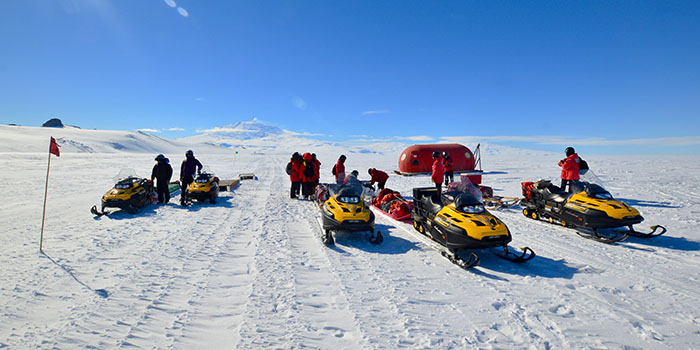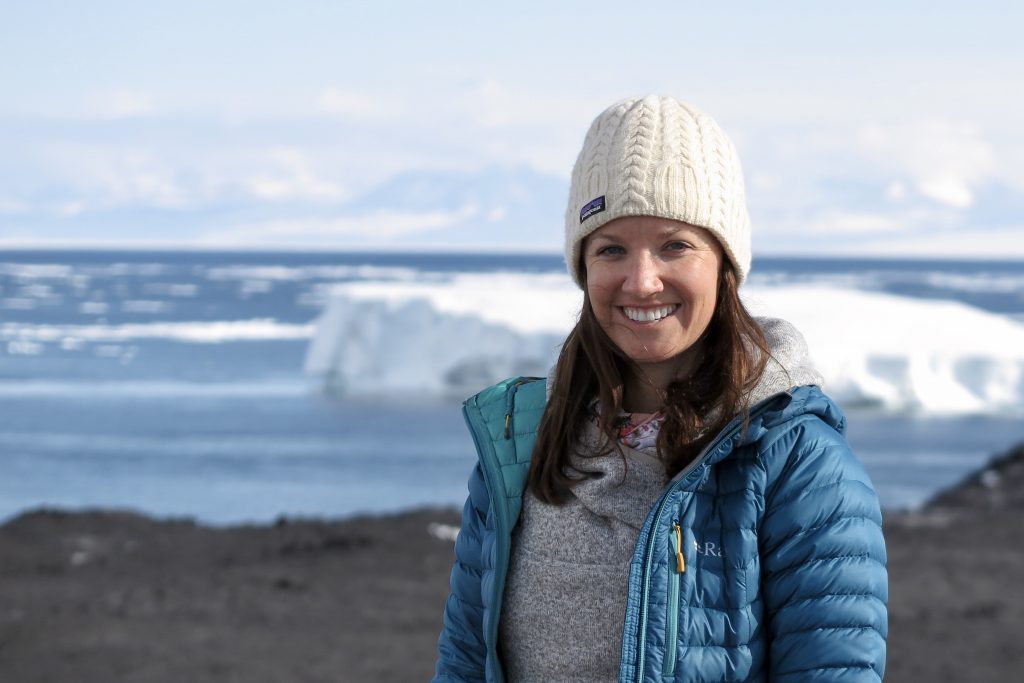Cold World Explorers
by Fatima Husain

Throughout their journeys in MIT’s Department of Earth, Atmospheric and Planetary Sciences (EAPS), students and researchers alike investigate the mysteries of the planet. Fieldwork, a critical component of geological study, takes some researchers to the ends of the Earth, and occasionally to some of the coldest, most remote environments known to humankind.
Emily Matys PhD ’18 from the EAPS Summons Lab, spent part of the 2018 southern hemisphere summer at McMurdo Station, the United States Antarctic research center located in McMurdo Sound. Matys works in geobiology and astrobiology—fields that sometimes look for life in extreme and ancient environments. She specializes in studying life in cold locations—from microbial mats at lake bottoms to the organisms that live in icy surface waters.
“For the most part, we were interested in looking at what lives underneath the ice, and what lives in the open ocean,” Matys says. Matys had traveled to Antarctica to learn how to study life on the continent as part of the National Science Foundation Antarctic Biology Training Program.
“People wonder if microbial communities [in Antarctica] are present because they’re selected for by the cold or just able to deal with the cold,” Matys says. To investigate this, Matys and her peers drilled or melted holes through thick layers of ice to access the waters and microbes of interest. Then, they’d characterize the water, measuring components such as temperature and conductivity, or collect samples to bring back to the station’s lab and culture them. There, they analyzed how Antarctic environmental conditions support life. “We took them from a very cold environment and exposed them to warmer temperatures or colder temperatures to see how they behaved. We found that they were actually able to grow a little bit better when exposed to warmer temperatures.”

Matys and her colleagues’ finding challenged the research community’s perception about life in the cold. “The conventional thought was that all of the organisms that live down there are best suited for the cold, and it’s not necessarily the case. They’re just tolerant of the cold,” she says.
When they weren’t out in the field or in the lab, Matys and the other researchers spent time in lectures about current and historical research topics on the base.
For Matys, Antarctica was a place to learn how to do fieldwork in variable and challenging conditions—and a springboard for potential future research studying life on icy moons.
On the other side of the globe, Lauren Kipp, an MIT-WHOI Joint Program graduate based in EAPS, spent nearly two months in 2015 aboard the U.S. Coast Guard’s icebreaker Healy tracking sediment transport from continental shelves into the Arctic Ocean. During this GEOTRACES research cruise—examining biogeochemical cycles and large-scale distribution of trace elements in the marine environment—Kipp and the team measured oceanic radium-228, a naturally occurring radioactive element in sediment. Using it as a chemical tracer, she investigated whether climate change via its effects on continental shelves could alter the chemistry of ocean water.
“It’s one of the regions of the world that’s being most affected by climate change, and so I like being able to study this really pressing and pertinent issue and all the ways that it’s going to affect the ocean,” Kipp says.
In the Arctic, shallow continental shelves cover more than half of the ocean; here, sediments accumulate and release compounds like radium into the sea. Ice melt and turbulent waters help to erode the coast and stir sediment up containing the saltwater soluble radium.
To understand and investigate how radium-228 traveled from Arctic coasts to the waters of the North Pole, Kipp measured radium in water samples along 69 stops as Healy broke through ice-laden waters. “We filtered what we wanted out of the seawater at depth and then brought those filters and cartridges back onto the deck,” Kipps says. “Then we analyzed those cartridges back in the lab at Woods Hole Oceanographic Institution (WHOI).” By the end of her cruise, Kipp says she filtered an estimated 286,868 liters of seawater, looking for changes in water chemistry and land-sea interactions due to climate change.
Her Arctic research revealed the unexpected. “Radium has a [continental] shelf source, so we expected it to be highest near the shelf. However, we were really surprised to see such high levels in the center of the ocean because that’s as far away as you can get from [the shelf],” Kipp says. The radium being transported rapidly into the central Arctic was about twice that seen during a previous GEOTRACES cruise in the region in 2007.
To explain the observations, Kipp turned to global ocean circulation maps. “It started to come together, because I realized there is this strong surface current [called the Transpolar Drift] that carries water from the shelf seas north of Russia across to the central Arctic, near the North Pole, where we measured it,” Kipp says. “The radium that we saw [in the ocean] was coming from that shelf,” Kipp says, not the Chukchi shelf that the Healy crossed earlier in the trip.
What could cause the doubling of radium levels over such a short period of time? Climate change. Kipp found that ice shelves in Russia were experiencing rapid and strong warming due to rising air and sea temperatures. The resultant loss of sea ice allowed winds and waves to increase water turbulence on the shelf and coastal erosion in the region. These factors ultimately added more sediments, including radium, to the ocean.
Kipp’s experience during the cruise ignited her fascination with the Arctic due to the territory’s susceptibility to climate change. “I think that’s a really great opportunity to increase public opinion about how climate change is currently affecting Earth’s oceans,” Kipp says.


